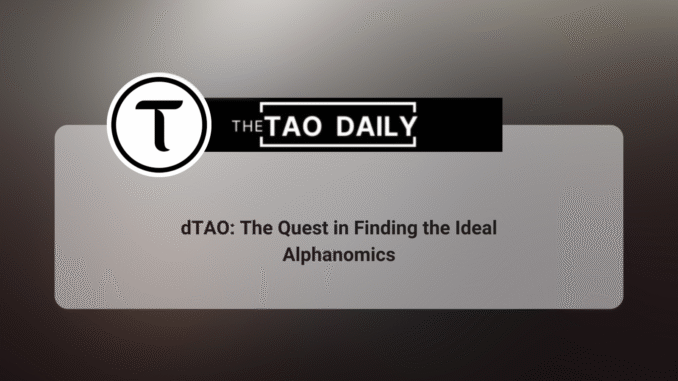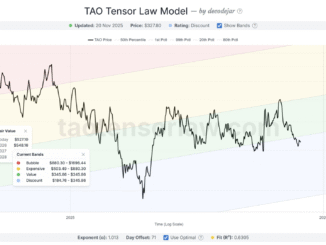
By: School of Crypto
It was supposed to be inevitable. Cosmos was going to be the next Ethereum. The next generation modular blockchain was a unique architecture that took the crypto world by storm. However, the “inevitable” didn’t end up coming to fruition. Inflationary pressure and lack of value accrual from the token holders seriously damaged its upward price momentum. Promising projects such as Celestia, Akash Network, and Injective that airdropped coins to stakers, spawned into their own blockchains and didn’t need Cosmos anymore.
This serves as a cautionary tale to all blockchain projects in the space. If you don’t have the proper tokenomics with an appealing value-added proposition to the token holders, the project is going to have a bad time.
Bittensor is in a bit of a discovery process in terms of its tokenomic infrastructure. Well, the main coin, TAO, has the elegant token infrastructure of the king itself, Bitcoin. It experiences a halving of the token emissions every 4 years just like Bitcoin. It also has a maximum supply of 21 million coins. Subnet owners, validators, and in some cases miners, need to have TAO in order to participate. All of this TAO gets locked up and taken out of the circulating supply. While this part of the Bittensor tokenomics has staying power, the subnet ecosystem, aka dTao, is still searching for the ideal value accrual mechanism to keep alpha token holders happy.
There are a few strategies that are currently being implemented within the dTao ecosystem. The most utilized mechanism so far is buyback and burn. Ridges, the exciting AI coding agent subnet, has floated the idea of utilizing its alpha tokens to exchange for some sort of equity in the final product. Hippius, the official storage subnet of Bittensor, requires its miners to stake the Alpha token in order to actually mine on the subnet.
Let’s break down all these current strategies and highlight the pros and cons of each one of them. Then we can analyze external economic structures within the broader crypto ecosystem and see if subnet owners could possibly implement them to properly compensate alpha stakers.
Buyback and burn
As stated, the buyback and burn mechanism is by far the most popular tokenomic strategy of subnet owners thus far. The basic concept is to alleviate cell pressure by buying tokens off the open market, burning them forever, and creating more scarcity to the Token itself.
This has actually been a well-documented and successful mechanism for a multitude of projects within the crypto space. Hyperliquid, the biggest decentralized Perpetual exchange on the planet, has implemented this buy-back program and has seen lots of success in elevating its token price within the calendar year. Meme coin launcher and up-and-coming streaming platform Pump.fun has also implemented the strategy and has seen an enormous jump in value after the initial selloff of the ICO.
Top subnet Chutes has implemented autobuybacks and burn, which would essentially guarantee that the subnet owner will never sell the subnet token. Infinitehash mines Bitcoin, converts it into TAO, then uses 90% of the proceeds to buy back their Alpha token. Mantis, the trading signal subnet, has plans to buy back their token in a couple of weeks.
Is this practice sustainable? Some question it a little bit. Stillcore Capital partner Rob Greer brought up an interesting point on a Ventura Labs episode that the money spent on buying back tokens could be better utilized. He emphasized that the funds could be used to better the business, and in turn, make more revenue based on those investments. Taking tokens out of the circulating supply and creating more scarcity is certainly a bullish endeavor. However, if the project doesn’t evolve and continue to grow, then ultimately the value of the token would theoretically suffer.
Alpha token for Revenues
One of the darlings in the Bittensor ecosystem Ridges came up with an interesting concept for their Alpha token utility. Shaq, the owner of subnet number 62, suggested that he could set aside 49% of the subnet’s future revenues to all Ridges token holders and they would be able to exchange those tokens for an equity stake in the subnet. This, of course, is a very exciting proposition for all Ridges holders. In the event that Ridges could even get a percentage of revenues that Claude Code gets, there would be a lucrative return for all investors involved.
However, this idea isn’t all sunshine and rainbows. Mark Jeffrey, a very highly regarded influencer in the Bittensor ecosystem, is a bit wary of this concept. In the above Ventura Labs podcast, he suggested that this could intertwine with legal scuffles and perhaps not be permitted or accepted within the United States legal framework. Securities have always been a hawkish take on crypto projects as a whole, and this could certainly be considered as one. That being said, Aave, the leading lending and borrowing DeFi dApp in crypto, rewards Aave stakers with a portion of the revenues they generate, and has not seen any public legal scrutiny.
Stake to mine, buyback, and earn more rewards
Perhaps the most unique tokenomics infrastructure that has been conceived thus far in the Bittensor ecosystem is that of storage subnet #75 Hippius. As explained on Mark Jeffrey’s Hashrate episode on Alphanomics, the concept is that miners need to bridge their tokens to the Hippius chain and stake them in order to even mine on the subnet. This creates an inherent utility of the token from the jump and then locks the tokens up out of the circulating supply. Hippius also compensates these Alpha token stakers with even more rewards by staking these tokens via a 100% buyback with revenues.
This specific mechanism shows a lot of promise but may have its holes as well. Perhaps some stakers don’t want that added friction to bridge their alpha tokens to another place and then have them locked up.
Tokenomic Idea for subnets
Buyback via TAM (Treasury Asset Manager)
An intriguing new strategy implemented this year was done by the decentralized stable coin powerhouse Ethena. A conglomerate of investment firms has built up a $890 million warchest to buy billions of the governance token ENA. Ethena themselves announced they would participate in this buyback program as well. The buy pressure is very bullish for the project and taking those coins out of circulating supply certainly helps with the scarcity.
But what happens when the money train stops? Will TAM’s without this treasure chest be able to succeed in a crypto bear market? There is a question whether the strategy can ultimately be sustainable, especially for treasury companies that don’t have hundreds of millions of dollars in their bank account.
veToken
The veToken concoction is a well-known one within the DeFi sector. Exchanges such as Curve Finance and Aerodrome Finance have implemented what is called a veToken infrastructure, which stands for a vote escrowed token lock.
Essentially, participants stake their tokens on the network and receive these veTokens in return. Stakers have the option to lock their tokens up for x amount of time. The longer the token is staked the more rewards you receive and also the more voting power you have in creating new schemes towards profitability.
This is clearly the skin in the game type strategy that generates a long-term holder base that ultimately gives them say in network activity and long-term growth in the actual protocol itself.
Token burn in each transaction
Ethereum is the second biggest blockchain project in the world and known to pass various proposals to continue to upgrade the network. Arguably the most consequential proposal that was passed was EIP-1559. This essentially created a novel burn mechanism each time an Ethereum transaction was passed on the network. Believe it or not, ever since this EIP was passed, the inflation has been less than Bitcoin.
Airdrops
Everybody in crypto loves a good old airdrop. Usually the way it works is that people will utilize a network that has not had a TGE (token generation event), in hopes of getting a future token airdropped into their wallet. There’s an old saying in crypto that if you get the early token holders rich, they will market your project free of charge through social media. This has worked out for some and not worked out for others.
For example, Hyperliquid did an airdrop and some received six figure type rewards just for using the platform. While the product is absolutely superior and that had a lot to do with its success, the airdrop clearly inspired many to stick with the project and promote it on social media at will.
However, an example of an airdrop not necessarily working out long-term was Hyperliquid’s competitor DYDX. Once upon a time, it was the top perpetual dex and also had a very lucrative airdrop that made a lot of people rich. However, Hyperliquid’s better latency, better product, and airdrop completely demolished its market share.
While airdrops are always welcomed by a crypto user, projects really need to focus on reducing churn and continually making the product better and giving the participants a reason to stay.
Incentivation programs
This is a common practice for a number of projects in the cryptocurrency space. One example that comes to mind is Avalanche. In 2021 they executed on a multi hundred million dollar incentivization campaign on a multitude of DEXs within its ecosystem. Basically if a user provided liquidity on its platform, they would receive a very high APY reward for boosting the TVL, or total value locked, on the network.
Avalanche still sits in the top 20 crypto projects in the space and this incentive program a few years back helped them get there. However, it’s not a guaranteed outcome for success. Many projects create similar incentives and farming pools only to see the users dump the token on the open market and move on to the next opportunity. The project or blockchain still needs to provide meta value in comparison to other competitors in the space in order to create proper staying power.
Where does this leave us?
Ultimately there needs to be some sort of value accrual for the token holder. This could be in the form of burning, buy back, airdrops, Revenue share, you name it. However the most important factor for a project to consider is the value of the network itself. If there is no demand for the actual product then the token will ultimately fail.
While tokenomics is certainly a very big piece of the pie, there’s very hard competition across the cryptosphere and participants need a lot of reasons to continue to be loyal to the product. Subnets within the Bittensor ecosystem need to focus on user stickiness, reduce churn and enhance their product while providing true value accrual and scarcity for the alpha token itself.




Be the first to comment